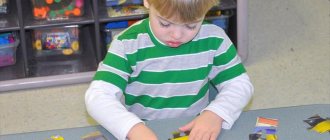What is thinking
Thinking is a cognitive process that allows a person to perceive, realize reality and express this in his own activities. It endows surrounding objects with properties and relationships with each other. Thanks to mental activity, each person’s picture of the world is formed.
There are the following main signs of thinking:
- Mediation – cognitive activity is based on data from the senses and does not interact directly with reality;
- Generalization is the ability to find common properties in objects of the same type.
These characteristics are inherent in every person. In mental illness, a disorder in the basic features of thought processes may occur - for example, the search for similarities in dissimilar objects.
Right-brain and left-brain thinking
Each hemisphere is characterized by the predominance of certain processes. Based on this feature, the main types of thinking were identified:
- Left hemisphere - the process is dominated by analytical and synthetic processes, logical constructions;
- Right-hemisphere - relies on images and intuition;
- Mixed is the alternate work of each hemisphere;
- Integrated – simultaneous work of both hemispheres.
It is wrong to say that one type of mental activity is preferable to another. Each of them is capable of coming to both correct and incorrect conclusions. Left-hemisphere thinking gives leadership qualities, right-hemisphere thinking gives a strong emotional response. Mixed, thanks to its ability to “switch,” can use the strengths of both hemispheres. But this process does not always happen on time. The same goes for the integrated type.
Thinking: what is it?
Before talking about the types of thinking and their characteristics, let's figure out what is called thinking:
Thinking is a mental process during which cognition and reflection of objective reality occurs through ideas, judgments and concepts. This is the highest form of human creative activity.
Thinking has several important characteristics:
- it helps a person to understand the world indirectly, through mediated experience;
- always relies on information received through the senses;
- operates through generalization, which allows us to highlight the essential qualities of objects and phenomena.
“I think, therefore I exist,” Rene Descartes, a 17th-century mathematician and philosopher, considered thinking to be the most important human ability.
Time has passed, but this idea has not lost its relevance. After all, a lot depends on thinking, or rather on the quality of thought processes: the ability to solve life problems, see cause-and-effect relationships, set and achieve goals, and achieve success.
Classification
In psychology, types of thinking are distinguished depending on the way a person comes to conclusions:
- Visual-effective - cognitive activity based on the perception of specific objects and manipulations with them;
- Visual-figurative – relies on images and judgments, allows the use of specific images to illustrate conclusions;
- Verbal-logical – based on logical constructions and inferences. Able to reason about abstract concepts;
- Subject-effective – close to visual-effective. Used to solve applied problems;
- Empirical - using lived experience to make inferences.
Each person has all types to one degree or another. The verbal-logical or abstract type develops later than the others. Characteristic only for humans. Other types appear to varying degrees in some animals. In essence, abstract thinking allows a person to use a wide conceptual apparatus and transfer knowledge through indirect sources - a book, an educational film, etc.
Classification of types of thinking
Developing in the process of socialization, a person’s way of thinking gradually changed, moving from the concrete to the abstract, from the external (objective) to the internal. Most often, thinking is divided into practical and theoretical. Practical thinking, in turn, can be visual-effective and visual-figurative, and theoretical thinking can be figurative and abstract-logical (conceptual). The main types of thinking can be depicted, according to this classification, in this way:
From visual-effective, the main type of thinking of a child up to 3 years old (we try everything by touch, “by tooth”), growing up (by 4-7 years), through visual images and ideas (auditory, tactile, visual, etc. ) we master visual-figurative thinking.
Theoretical and practical thinking differ in the type of problems they solve and in the resulting features (structural and dynamic). Theoretical thinking is considered to be at a higher level of development than practical, and conceptual (verbal-logical) thinking is at a level higher than figurative. It is interesting that even in the process of carrying out any specific activity, all these types of thinking can peacefully coexist, but one of them always dominates, based on the ultimate goals and nature of this activity. In this regard, we can talk about the prevailing type of thinking at the moment. All types of human thinking are equivalent in terms of complexity, as well as in terms of the requirements for human abilities, and first of all, for intellectual abilities.
Let's look in more detail at each type of thinking process:
Visually effective type
This is the earliest form of mental activity that develops in humans. It is typical for children under 3 years of age. Mental operations are based on manipulations with really existing tangible objects. Each problem is solved immediately at the practical stage, during manipulations with objects. Thinking disorders of this type are rare. Mainly with severe mental retardation. They lead to the fact that the process of development of brain activity as a whole slows down or stops.
How and when does developmental disorder develop?
This is the first stage in the development of mental activity. The time frame for its development to begin varies. Some experts indicate that a child is capable of simple mental operations from birth. Others say that the development of mental processes is closely related to the ability to move and appears simultaneously with a decrease in muscle hypertonicity. Estimated time frame: 6 months – 1 year.
Vivid and uncontrolled manifestations of visual-effective thinking in children over 3 years of age, adolescents and adults indicate serious mental disorders - mental retardation, regression in psychosis. The patient exhibits a pronounced desire to grab, break and hide surrounding objects.
Manual or visual-effective thinking of children and ways of its development
This type of solving life problems got its name due to the fact that the child constantly performs some kind of manipulation with surrounding objects. The most striking manifestations are the baby grabbing toys, knocking them, testing them, licking them, trying to take them apart and put them back together.
It makes no sense to wean a child from these manipulations; a much more important task for parents is to provide the child with toys that he can disassemble and assemble without damaging them. An excellent option is sorters. This educational toy has many functions and modifications. The principle of operation is usually similar - assemble, disassemble, correlate colors, edges, shapes. This is both a puzzle and a construction set in one toy. Check out the selection of smart toys in different prices and variations.
Visually effective type of thinking in adults
In adults, such mental operations are involved in cases where the result of actions cannot be predicted on the basis of existing inferences. A striking example is mastering an unfamiliar technique. Arrangement of furniture in the room or objects on the table, selection of necessary materials according to shape, texture, subjective sensations.
Why is it important to develop thinking?
Visual and effective thinking is the starting point for the formation of other forms of intelligence. It is necessary for the independent existence of the individual. You can't do without it in everyday life.
What is the obstacle?
Important. The formation of visual and effective thinking is a natural process for a healthy child. Due to their natural inquisitiveness and temperament, some children go through this path themselves, while others need parent guides who will help, explain, and show.
We talked more about the features of visual-effective thinking in children here.
It is important to provide the opportunity to study the world around us and the processes occurring in it. But there are “special” children with intellectual disabilities who need to be worked with through repeated repetitions of certain actions.
Exercises that help you gain skills
The curiosity of children is a good incentive for the development of this thinking. The task of parents is not to block cognitive activity , while monitoring safety.
Choose multifunctional toys, various types of construction sets, and materials for children's creativity. Give your child the opportunity to participate in all household chores, using household appliances and other “adult things” under close supervision, explain, show.
Play role-playing games. Ask your child:
- feed the doll;
- ride the bear;
- give the bunny a bath.
Older children can draw shapes on a checkered piece of paper and invite them to repeat them.
As for adults, this type of thought process can be trained with the help of chess, puzzles, and modeling. You can also perform special exercises, for example:
- Take a box of matches and make shapes from them.
- Master origami.
- Draw various triangles, circles, and rhombuses on a piece of paper. Then, using scissors, cut each shape into a square.
Visual-figurative type
This form of thinking manifests itself in the fact that the child is able to imagine the final result of his actions. With the visually effective method, the baby has no idea about the result of his actions, but remembers the relationships as a result of repetition. With visual-figurative learning, the preschooler guesses what the result will be.
How and when it develops, what developmental disorders exist
Visual-figurative thinking is formed on the basis of visual-effective thinking. Formation begins at the age of about 3 years. This is the main type of mental activity of preschoolers. Reaches a peak at 5-6 years.
Signs that the baby has the beginnings of imaginative thinking:
- he is able to recognize objects without touching them,
- is able to select several similar objects,
- break simple tasks into several interconnected components.
Tools for developing an imaginative way of thinking - prefabricated toys (pyramids, cubes, puzzles -), then - observing nature, retelling what you heard, drawing from memory. The criterion that imaginative thinking is actively developing is that the baby can describe his actions before starting them.
Visual-figurative thinking disorders in childhood are a lack of skills characteristic of this stage, loss of interest in complex toys. In adults, such disorders look like this:
- Aimless manipulation of objects. Example – a patient may strike a lighter for a long time and aimlessly;
- Ridiculous actions with objects that create the feeling of a child's game;
- Imitative actions;
- Mimo actions - similar to correct ones, but deliberately ineffective (lighting a match with the other end);
- Destructive actions - aggressive or auto-aggressive.
This behavior is typical for patients with psychosis, catatonic disorders, and schizophrenia.
How do images help in mental activity?
An image is a holistic idea of the result of one’s activities. It becomes the basis for the formation of more complex abstract thinking and supports the ability to perceive holistically. In adults, the main function of images is setting goals for their actions, emotional involvement in activities, and the formation of a creative approach.
Important
Imaginative thinking can only work with those phenomena that it has already encountered, so observation is extremely important at this stage of development. Emotions are always included in the perception of an image - this is important for both children and adults engaged in creative work. At the same time, this type of brain work is not characterized by special attention to detail - it notices the important and essential qualities of an object, while the rest can be distorted or discarded.
The process of thinking formation
From birth to about three years of age, a child discovers the world by seeing and touching objects around him. Babies are interested in absolutely everything – from their mother’s eyes to a fluffy cat. But it’s not enough to just see – they need to touch things that are nearby. Thus, with the help of touch, they begin to understand what is wet and what is dry, what is smooth and what is rough.
WE RECOMMEND WATCHING: Memory and attention training for the elderly
To understand what an object it is, the baby must touch it, often even taste it. This is how he prepares for mental activity. In the desire to understand the features of this or that toy, the child comes to the idea that he is trying to find out how it works, what is inside it. As a result, the toy often breaks. Parents who scold their child in such cases are wrong. In fact, in this action of the baby lies the desire to explore the world; this is the first stage in the development of research activities.
The thought processes occurring in the brain of a small child during this period differ from the same processes in an adult. The main difference is the child’s transition to active action in an attempt to solve a problem. An adult first understands how and what needs to be done.
Examples of visually effective thinking: a child wants to get a toy that is in the closet on the top shelf. Due to his short stature, he cannot reach. What is the baby doing? He takes the chair, puts it next to the closet, climbs in and takes out a toy. Such actions are typical for a child of 2–3 years of age.
Older children (5 years old) can form a preliminary picture of this action in their minds, where they predict the result. They “picture” in their imagination what will happen if, for example, a chair wobbles. The possible result of the actions will force the baby to be more careful or call an adult. This is already visual-figurative thinking.
It's more complex. During his development, the baby imagines what will happen after he performs certain actions. This is a significant stage in the development of a person’s brain activity (especially a preschooler), which is necessary in the process of further learning, because to learn any science is to be able to think.
The highest form of development of thinking processes is verbal-logical. Its features:
- is based on the base of linguistic means;
- concepts are used;
- logical constructions are used;
- characterizes the late stage of development of human thinking.
Verbal-logical thinking is the ability to think using concepts that are expressed in speech. When a baby says a word, a specific object appears before his mind's eye. For example, when hearing the word “cat,” the image that comes to mind is exactly the animal that he saw (in a book or at home). Over time, the baby will learn to generalize all subjects.
WE RECOMMEND SEEING: Which part of the brain is responsible for memory?
Abstract boolean type
Abstract thinking operates not only with images, but also with abstract concepts. A person who has developed this type of mental activity is able to systematize information and purposefully search for it, and plan his activities. It is considered the highest degree of development of brain activity, characteristic only of humans.
How and when it develops, possible developmental disorders
The formation of abstract thinking begins at 5-7 years of age. Late preschool and early school period. The full ability to operate with abstract concepts is formed in adolescents and remains throughout life.
Signs that a preschooler has begun to develop logical thinking:
- meaningful use of abstract concepts in speech,
- the emergence of the skill of detailed planning of one’s activities,
- understanding cause-and-effect relationships in the actions of others.
All these operations occur without direct contact with objects.
Impaired brain activity manifests itself in the inability to generalize, highlight the main thing, and understand the figurative meaning of words and expressions. To identify such disorders, tests are used in which you need to interpret a proverb or saying and identify fundamental similarities between different objects.
Peculiarities
This type of thinking uses complex logical operations. In adolescents and adults it is the main one. Thanks to it, a person is able to plan, set goals and evaluate their feasibility, evaluate his own actions and the actions of others, draw conclusions and learn from his own and others’ experiences. Characterized by deep attention to detail, understanding of context, low emotional involvement.
12.4. Types of thinking
There are several classifications of types of thinking for various reasons
1. The basis for classification (genetic) can be the means of solving the problem
, which are action, image and concept. In accordance with this, the following types of thinking are distinguished:
Visual-effective thinking, which is characterized by the fact that the solution to a problem is carried out through action, a real transformation of the situation. Animals also have this type of thinking. So. The classical experiments of the Gestalt psychologist W. Köhler (1987-1967) on the study of practical intelligence in chimpanzees are widely known. The monkeys had to solve problems like pulling up a banana with a stick. Sometimes this required making a long stick out of two short ones. The success of the decision was made dependent on the vision of the situation as a whole, on the “gestalt” of the field of perception. Initially, the chimpanzee's field of perception includes a banana and an obstacle that prevents him from getting this banana. A stick is then incorporated into this structure. Thus. By establishing a connection between the banana and the stick, the monkey moves to a new structure, thereby solving the problem.
Visual-figurative thinking. Here the means of solving the problem is an image. Unlike the visually effective. in visual-figurative thinking, transformation occurs only in the figurative plane - we mentally do it. what was done with the help of real action.
Verbal-logical is one of the main types of thinking. which uses concepts and logical constructs that exist on the basis of language as means of solving a problem.
All three types of thinking form stages of development of thinking in ontogenesis and phylogenesis. However, in an adult, all these three types of thinking coexist.
2. Based on the product that a person receives as a result of his mental activity, a distinction is made between productive (creative) and reproductive (reproducing) thinking.
Productive thinking is characterized by a high degree of novelty of the product obtained on its basis. The concept of “productive thinking” was introduced by Gestal psychologists. They believed that thinking is a transition from one structure to a new one, that is, a restructuring of the situation. The emergence of a new structure occurs as a result of insight, that is, illumination. It is carried out immediately, instantly. I suggest you solve the following problem in order to better understand the ideas of Gestalt psychologists about the essence of the thinking process. You need to calculate the area of the following figure:
Specific subject type
A selection of construction kits that perfectly develop subject-specific thinking
Like visual-effective thinking, the concrete-object type is associated with direct interaction with objects, but is its more developed type. A person with concrete-subject thinking, unlike a small child, has a goal and imagines the result of his actions. This type of mental activity accompanies applied operations, most often in the technical field. It allows you to “adjust” certain devices to a specific situation.
How and when does developmental disorder develop?
Practical thinking begins to develop around 4-7 years, the start time is quite flexible. What is needed is a developed visual-figurative method and the presence of at least the rudiments of the abstract-logical. This type of mental activity is formed on the basis of constant work with hands, requiring a creative approach. He is well developed by construction sets and other complex toys - a good selection.
Developmental disorders manifest themselves in the form of an inability to follow instructions, difficulty in moving from theory to practice.
Development of thinking: ways to train the brain
Thinking can rightfully be called the crown of human knowledge. It is a mental activity with its own goals, motives, operational functions and results. It can be characterized in different ways: as the highest degree of assimilation and processing of information and the establishment of cause-and-effect relationships between objects of reality, as a process of displaying the obvious properties of objects and phenomena and, consequently, the formation of ideas about the surrounding reality, and as a process of cognition of the world based on on the continuous replenishment of the baggage of concepts and ideas about it.
But, regardless of the interpretation, it can be established that the better a person’s thinking is developed, the more effectively he can interact with the world around him and other people, study and cognize, understand phenomena and truths. Thinking is formed as a person develops from his very birth, but life circumstances do not always develop in such a way that it continues to develop. It often happens that, having reached a certain level, development slows down. However, each of us is able to influence this process, like many others. In other words, everyone is capable of developing their own thinking, and we will talk about how this is done in this article.
But before we get down to the main material, we should say a few words about what thinking is like in general. In total, there are several of its main types, studied by specialists most often and most of all:
- Visual-figurative thinking;
- Verbal-logical (aka abstract) thinking;
- Visual-effective thinking;
- Logical thinking;
- Creative thinking.
Below we will provide a brief description of each type of thinking and indicate effective and simple ways to develop them.
Visual-figurative thinking and exercises for its development
With the help of visual-figurative thinking, reality is transformed into images, and ordinary phenomena and objects are endowed with new properties. It involves visually solving problems and problems without the need to resort to practical actions. The right hemisphere of the brain is responsible for its development. Visual-figurative thinking should not be confused with imagination, because... it is based on real objects, actions and processes, and not imaginary or fictitious ones.
Visual-figurative thinking can be developed in adults and children in the same ways. Here are some good exercises:
- Remember several people with whom you had the opportunity to communicate today, and imagine in detail their clothes, shoes, hairstyle, appearance, etc.
- Using just two nouns, one adverb, three verbs and adjectives, describe the words "success", "wealth" and "beauty".
- Try some thought experiments: imagine the shape of your pet's ears or, for example, an elephant; count the number of apartments in your entrance and imagine how they are located in the house; Now turn the English letter “N” 90 degrees and determine what came out of it.
- Describe the following objects and phenomena in words: a flying swan, flashing lightning, the kitchen of your apartment, lightning, a pine forest, a toothbrush.
- Recall in your memory the image of a recent meeting with friends and give mental answers to several questions: how many people were in the company, and what clothes did each of them wear? What food and drinks were on the table? What were you talking about? What was the room like? What position did you sit in, what sensations did you experience, what did you taste from the food and drinks you consumed?
These exercises can be modified at your discretion - you can do whatever you want, but the main thing here is to use visual-figurative thinking. The more often you use it, the better it will develop.
You can also check out a course that will help you develop your thinking in just a few weeks. Check it out here.
Verbal-logical (abstract) thinking and exercises for its development
Verbal-logical thinking is characterized by the fact that a person observing a certain picture as a whole isolates from it only the most significant qualities, not paying attention to unimportant details that simply complement this picture. There are usually three forms of such thinking:
- Concept – when objects are grouped according to characteristics;
- Judgment - when any phenomenon or connections between objects are affirmed or denied;
- Inference – when specific conclusions are drawn based on several judgments.
Everyone should develop verbal and logical thinking, but it is especially useful to develop it from an early age in children, because this is an excellent training for memory and attention, as well as imagination. Here are some exercises you can use for yourself or your child:
- Set a timer for 3 minutes, during this time write the maximum number of words starting with the letters “zh”, “w”, “ch” and “i”.
- Take a few simple phrases, such as “what’s for breakfast?”, “let’s go to the movies,” “come visit,” and “there’s a new exam tomorrow,” and read them backwards.
- There are several groups of words: “sad, cheerful, slow, cautious”, “dog, cat, parrot, penguin”, “Sergey, Anton, Kolya, Tsarev, Olga” and “triangle, square, board, oval”. From each group, select those words that do not fit the meaning.
- Identify the differences between a ship and an airplane, grass and a flower, a story and a poem, an elephant and a rhinoceros, a still life and a portrait.
- A few more groups of words: “House - walls, foundation, windows, roof, wallpaper”, “War - weapons, soldiers, bullets, attack, map”, “Youth - growth, joy, choice, love, children”, “Road - cars, pedestrians, traffic, asphalt, poles.” Choose one or two words from each group, without which the concept (“house”, “war”, etc.) could exist as such.
These exercises, again, can be quite easily modernized and modified, simplifying or complicating them at your discretion. It is because of this that each of them can be an excellent way to train abstract thinking in both adults and children. By the way, any such exercises, among other things, perfectly develop intelligence.
Visually effective thinking and exercises for its development
Visual-effective thinking can be described as the process of solving mental problems by transforming a situation that has arisen in real life. It is rightfully considered the first way to process received information, and it develops very actively in children under 7 years of age, when they begin to combine all kinds of objects into one whole, analyze them and operate with them. And in adults, this type of thinking is expressed in identifying the practical benefits of objects in the surrounding world, being the so-called manual intelligence. The left hemisphere of the brain is responsible for the development of visual and effective thinking.
An excellent way to learn and train here is the usual game of chess, making puzzles and solving puzzles, sculpting all kinds of plasticine figures, but there are also several effective exercises:
- Take your pillow and try to determine its weight. Then “weigh” your clothes in the same way. After this, try to determine the area of the room, kitchen, bathroom and other areas of your apartment.
- Draw a triangle, a rhombus and a trapezoid on album sheets. Then take your scissors and turn all these shapes into a square by cutting once in a straight line.
- Place 5 matches on the table in front of you and make 2 equal triangles from them. After that, take 7 matches and make 2 triangles and 2 squares from them.
- Buy a construction set at the store and use it to create various shapes - not just those indicated in the instructions. It is recommended that there be as many details as possible - at least 40-50.
As an effective complement to these exercises, chess, etc., you can use our excellent course on developing thinking.
Logical thinking and exercises for its development
Logical thinking is the basis of a person’s ability to think and reason consistently and without contradictions. It is necessary in most life situations: from ordinary dialogues and shopping to solving various problems and developing intelligence. This type of thinking contributes to a successful search for justifications for any phenomena, a meaningful assessment of the world around us, and the competent construction of speech and judgments. The main task in this case is to obtain true knowledge about the subject of reflection with the basis for analyzing its various aspects.
Among the recommendations for the development of logical thinking are solving logical problems (and this is also an excellent training of memory and attention in children and adults), passing IQ tests, logical games, self-education, reading books (especially detective stories), arguing and intuition training.
As for specific exercises, we advise you to take note of the following:
- From several sets of words, for example: “chair, table, sofa, stool”, “circle, oval, ball, circle”, “fork, towel, spoon, knife”, etc. you need to choose a word that does not fit the meaning. Despite its simplicity, this is a very effective technology for developing logical thinking, and similar sets and exercises can be found in large quantities on the Internet.
- Group exercise: Get together with friends or the whole family and divide into two teams. Let each team invite the opposing team to solve a semantic riddle that conveys the content of some text. The point is to determine what kind of text it is. Here is a small example: “The clergyman had an animal on the farm. He had strong warm feelings for him, however, despite this, he carried out a violent action on him, which led to his death. This happened for the reason that the animal did something unacceptable - it ate part of the food that was not intended for it.” Thinking logically, one can recall a children's song that begins with the words: “The priest had a dog, he loved it...”
- Another group game: a member of one team performs an action, and a member of the other must find the reason for it, and then the reason for the reason, and so on until all the motives for the behavior of the first participant are clarified.
Let us repeat that these exercises (in particular the last two) are excellent ways to develop logical thinking and intelligence, suitable for people of all ages.
Creative thinking and exercises for its development
Creative thinking is a type of thinking that allows you to organize and analyze ordinary information in an unusual way. In addition to the fact that it contributes to an extraordinary solution to typical tasks, questions and problems, it also increases the efficiency of a person’s assimilation of new knowledge. Using creative thinking, people can consider objects and phenomena from different angles, awaken in themselves the desire to create something new - something that did not exist before (this is the understanding of creativity in its classical sense), develop the ability to quickly switch from one task to another and find many interesting options for doing work and ways out of life situations.
Methods for developing creative thinking are based on the idea that a person realizes only a small percentage of his potential during his life, and his task is to find opportunities to activate unused resources. The technology for developing creativity is based primarily on several recommendations:
- You need to improvise and always look for new ways to solve everyday problems;
- There is no need to focus on established frameworks and rules;
- You should expand your horizons and constantly learn something new;
- You need to travel as much as possible, discover new places and meet new people;
- You need to make learning new skills and abilities a habit;
- You need to try to do anything better than others.
But, of course, there are also certain exercises for the development of creative thinking (by the way, we advise you to familiarize yourself with our courses on the development of creative thinking and thinking in general - you will find them here and here).
Now let's talk about exercises:
- Take several concepts, for example, “youth”, “man”, “coffee”, “teapot”, “morning” and “candle”, and select for each of them the maximum possible number of nouns that define their essence.
- Take several pairs of different concepts, for example, “piano – car”, “cloud – locomotive”, “tree – picture”, “water – well” and “plane – capsule” and select the maximum number of similar features for them.
- Imagine several situations and think about what could happen in each of them. Examples of situations: “aliens are walking around the city”, “not water, but lemonade is running from the tap in your apartment”, “all domestic animals have learned to speak human language”, “it snows in your city in the middle of summer for a week.”
- Look around the room where you are now and stop your gaze on any object that interests you, for example, on a closet. Write down on a piece of paper 5 adjectives that go with it, and then 5 adjectives that are completely opposite.
- Think about your job, hobby, favorite singer or actor, best friend or significant other, and describe it (him/her) in at least 100 words.
- Remember some saying or saying, and write a short essay, poem or essay based on it.
- Write a list of 10 purchases you would make before the end of the world.
- Write a daily plan for your cat or dog.
- Imagine that, upon returning home, you saw that the doors of all apartments were open. Write 15 reasons why this could happen.
- Make a list of 100 of your life goals.
- Write a letter to your future self - when you are 10 years older.
Also, to activate your creativity and intelligence, you can use two excellent methods in everyday life - synectics and brainstorming. These ways to develop creativity will help you destroy all stereotypes, expand your comfort zone and develop an original and unique type of thinking.
In conclusion, we will say that if you have a desire to organize or continue your education and develop your thinking more effectively, then you will certainly like one of our courses, which you can find at this link.
Otherwise, we wish you every success and well-rounded thinking!
We also recommend reading:
- Storytelling
- Cognitive processes
- Types of thinking
- Intelligence and its development: several recommendations
- Thinking techniques
- How and why to develop thinking
- Language and thinking
- The best blog materials in 2021: thinking development, brain training, self-education
- Combinatorial thinking
- Thinking games
- Koos Cubes
Key words:_D1025, 1Cognitive science
Forms (criteria) of thinking
Thinking operates with several basic categories, which are characteristic mainly of the abstract-logical type.
- A concept is the simplest act of mental activity. It reflects the very fact of understanding objects or phenomena. The external manifestation of the concept is the ability to name an object using its main features (black cat, cold rain, bad mood, etc.).
- Judgment is the ability to establish relationships between concepts and combine them into groups. External expression is the ability to describe one concept using others in a sentence. Examples of judgments: a cat and a dog are animals; rain is precipitation in the form of water.
- Inference - allows you to derive new judgments from existing ones that are interconnected. An example of a conclusion: rain is precipitation in the form of water, in winter the water freezes, which means rain is possible only in summer. Inferences can be true or false. An example of an incorrect inference is that a cat is an animal, the cat meows, which means all animals meow.
A separate type of inference is a hypothesis. It is based partly or entirely on assumptions and requires verification and evidence. In everyday life, a person makes several hundred inferences a day. For example, from the readings of the thermometer outside the window, he makes a conclusion about what clothes to wear.
Operations of thinking
- Operations are unique units of measurement for thinking. At their expense, mental activity is carried out. They are present at any stage of development of intellectual abilities, but manifest themselves in different forms.
- Comparison is the search for differences and similarities between objects. Based on comparison, objects can be grouped based on similarity.
- Analysis is the division of an object into its components. At the simplest stage, it is accompanied by physical separation of the object (the child breaks toys).
- Synthesis is an operation opposite to analysis - recreating the appearance of a whole object from its parts.
- Abstraction is the selection of essential features of an object, ignoring non-essential ones.
- Concretization is an operation opposite to abstraction - identifying the specific characteristics of an object, perceiving its diversity.
- Induction is the derivation of conclusions from the particular to the general, the distribution of knowledge about a specific object to the entire group of similar objects.
- Deduction is an operation opposite to induction - drawing conclusions from the general to the particular, distributing knowledge about a group of objects to each object of this group.
Read more in the article Deductive Reasoning
- Classification is the division of objects according to their differences. Performed on a comparison basis.
- Generalization - identifying common features for different objects. This operation is performed on a comparison basis.
Types of thinking
Types of thinking are features associated with which of the operations predominates during the formation of inferences. This does not mean that the others are not fulfilled. The brain cannot limit itself to one type of operation, otherwise all conclusions will be incorrect.
Deductive
It is based on initial statements that are valid for most cases (axioms, less often hypotheses). From them, through a chain of logical conclusions, a conclusion is drawn that is fair in a certain situation. An important condition is that the original statement must be true.
Critical
This type of thinking is based on knowledge, information analysis and individual personality traits. In psychiatry, critical thinking refers to the ability to evaluate the appropriateness of one's behavior.
Inductive
This is the ability to form conclusions based on private knowledge and personal experience, to draw conclusions that should be valid for the entire group of objects. Judgments will be correct if the feature that unites objects into a group is chosen correctly.
Analytical
Based on the operation of analysis, it is highly structured, orderly, and has a deep understanding of the essence of processes. Weakness: low ability to organize activities.
Investigative
A combination of analysis and setting new tasks. Allows you to study objects in more detail, identify relationships and formulate tasks for the future.
You may also be interested in reading Profiling. 10 rules and 20 tricks to read people like a book
Systematic
Based on identifying the relationships between objects and their deep understanding. Perception of the surrounding world in interaction.
Creative
The main feature is flexibility, the search for new goals or new ways to achieve known goals.
Synthetic
It's about putting together different "pieces of the puzzle." Allows you to plan tasks, set important goals, and highlight the most significant details.
Interrogative
This type combines all operations equally. The main way of knowledge is to ask questions, find answers to them, from which new questions follow.
Divergent
This type of thinking finds a number of alternatives for any action, from which it consistently chooses the optimal path.









